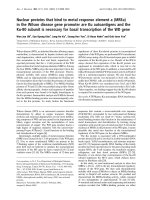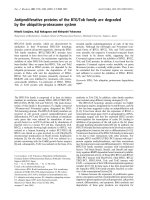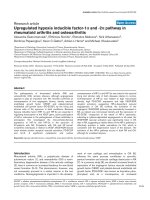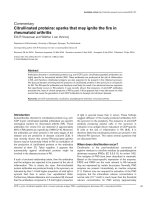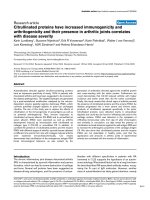Báo cáo y học: " Citrullinated proteins: sparks that may ignite the fire in rheumatoid arthritis" ppt
Bạn đang xem bản rút gọn của tài liệu. Xem và tải ngay bản đầy đủ của tài liệu tại đây (122.55 KB, 5 trang )
107
CCP = cyclic citrullinated peptide; HLA = human leukocyte antigen; PAD = peptidylarginine deiminase; RA = rheumatoid arthritis.
Available online />Introduction
Autoantibodies directed to citrullinated proteins (e.g. anti-
CCP [cyclic citrullinated peptide] antibodies) are specific
serological markers for rheumatoid arthritis (RA). These
antibodies (for review [1]) are detected in approximately
80% of RA patients at a specificity of 98% [2–4]. Moreover,
the antibodies are often present in the early stages of the
disease and are predictive of disease outcome [5,6]. It
was recently shown that several RA-associated genetic
factors may be functionally linked to RA via modulation of
the production of citrullinated proteins or the antibodies
directed at them [7]. Taken together, it appears that
autoreactivity against citrullinated proteins might be
involved in the disease process in RA.
If such a functional relationship exists, then the antibodies
and the antigens are expected to be present at the site of
inflammation. This is clearly the case. Anti-citrullinated
protein antibodies are produced locally in the synovium, as
indicated by their 1.4-fold higher proportion of total IgG in
synovial fluid than in serum (our unpublished data).
Furthermore, Masson-Bessière and coworkers [8] showed
that the antibodies comprised a 7.5-fold higher proportion
of IgG in synovial tissue than in serum. These findings
suggest diffusion of the locally produced antibodies from
the synovium to the periphery. The presence of anti-CCP
antibody producing plasma cells in the synovium is
indicative of an antigen-driven maturation of CCP-specific
B cells at the site of inflammation in RA [8,9]. It is
therefore likely that citrullinated proteins are present in the
inflamed RA synovium. This raises several questions that
are discussed here.
When does citrullination occur?
Citrullination is the post-translational conversion of
arginine residues to citrulline residues by peptidylarginine
deiminase enzymes (PADs; EC 3.5.3.15; for review [10]).
Five isotypes of PAD have been described in mammals.
Based on the tissue-specific expression of the enzymes,
PAD2 and PAD4 are the most relevant to RA because
they are expressed by certain leucocytes. Normally, PAD
enzymes are present intracellularly as inactive enzymes
[11]. Calcium ions are required for activation of the PAD
enzymes, but the intracellular calcium concentration in
normal cells (10
–7
mol/l) is much lower than the threshold
calcium concentration for PAD activity (approximately
Commentary
Citrullinated proteins: sparks that may ignite the fire in
rheumatoid arthritis
Erik R Vossenaar and Walther J van Venrooij
Department of Biochemistry, University of Nijmegen, Nijmegen, The Netherlands
Corresponding author: Erik R Vossenaar (e-mail: )
Received: 28 Jan 2004 Revisions requested: 15 Mar 2004 Revisions received: 5 Apr 2004 Accepted: 5 Apr 2004 Published: 19 Apr 2004
Arthritis Res Ther 2004, 6:107-111 (DOI 10.1186/ar1184)
© 2004 BioMed Central Ltd
Abstract
Antibodies directed to citrullinated proteins (e.g. anti-CCP [cyclic citrullinated peptide] antibodies) are
highly specific for rheumatoid arthritis (RA). These antibodies are produced at the site of inflammation
in RA, and therefore citrullinated antigens are also expected to be present in the inflamed synovium.
We discuss literature showing that the presence of citrullinated proteins in the synovium is not specific
for RA. The RA-specific antibodies are therefore most likely the result of an abnormal immune response
that specifically occurs in RA patients. It was recently shown that presence of anti-CCP antibodies
precedes the onset of clinical symptoms of RA by years. It thus appears that it may take years for initial
events that cause the generation of anti-CCP antibodies to develop into full-blown disease.
Keywords: anti-CCP autoantibodies, citrullination, peptidylarginine deiminase, rheumatoid arthritis
108
Arthritis Research & Therapy Vol 6 No 3 Vossenaar and van Venrooij
10
–5
mol/l; our unpublished observations and data from
Takahara and coworkers [12]). During cell death, however,
the integrity of the plasma membrane is lost [13,14],
causing influx of calcium from the extracellular space and
subsequent activation of intracellular PAD [11,15–18].
Alternatively, PAD enzymes may leak out of the dying cells,
become activated (the extracellular calcium concentration is
approximately 10
–3
mol/l, which is sufficient for PAD activity
[12]), and cause citrullination of extracellular proteins.
Which citrullinated proteins are likely to be
found in the RA synovium?
Many cells in the inflamed synovium have fragmented
DNA, which is generally considered a sign of apoptosis.
Nevertheless, these cells lack an apoptosis-specific
morphology, and the presence of large numbers of
apoptotic cells in the inflamed synovium is therefore still
debated [19]. This discrepancy could be explained by the
possible occurrence of impaired apoptosis. It may be that
the apoptotic process is halted or that apoptotic cells
switch to necrosis. In both cases, PAD enzymes may
become activated by raised intracellular calcium levels, as
probably is the case during the terminal differentiation of
keratinocytes [20], a process that exhibits many parallels
with halted apoptosis. We recently found that vimentin is
citrullinated in dying human macrophages [11]. Because
macrophages are abundant in the RA synovium, it is not
surprising that citrullinated vimentin is present in the
synovium as well. Indeed, the Sa antigen, which was
recently identified as citrullinated vimentin [21], can be
detected in pannus tissue [22]. The Sa antigen is
specifically targeted by autoantibodies in RA sera (for
review [23]).
In the inflamed synovium, oxygen metabolism is in
disequilibrium. This leads on one hand to sites with oxygen
excess (and subsequent generation of reactive oxygen
species) and on the other hand to sites of hypoxia, which
can cause synovial tissue microinfarctions [24,25]. At
these sites, plaques containing extravascular fibrin are
commonly found. Masson-Bèssiere and coworkers [26]
have shown that such deposits contain citrullinated
proteins. One of these proteins could be identified as
citrullinated fibrin, which is efficiently recognized by
autoantibodies present in RA sera.
Although the presence of citrullinated histones in the
inflamed synovium has not (yet) been reported, it is not
unlikely that they are present. Citrullination of histones has
been described ex vivo during calcium-ionophore induced
apoptosis of granulocytes [17,18]. Large numbers of
granulocytes are present in the inflamed synovium,
especially in the synovial fluid. Because granulocytes have
a lifespan of only about 3 days, they will die in large
numbers at the site of inflammation, which may trigger
histone citrullination.
In summary, although many different citrullinated proteins
may be present in the RA synovium, thus far three proteins
can be considered as candidate autoantigens in RA:
citrullinated fibrin, citrullinated vimentin and citrullinated
histones.
Is the occurrence of synovial citrullinated
proteins a phenomenon specific to RA?
Two possible explanations may be considered for the high
specificity of autoantibodies directed to citrullinated
antigens for RA. One possible explanation is that there is
an RA-specific overexpression of citrullinated antigens in
the rheumatoid synovium that leads to an immune
response. Alternatively, presence of citrullinated proteins
may be a common phenomenon in any inflamed (synovial)
tissue but RA patients may have an abnormal humoral
response to them.
The first possibility is supported by the finding of genetic
polymorphisms in the PAD4 gene [27]. One haplotype of
PAD4 was associated with susceptibility for RA. Although
it was not shown whether the PAD4 encoded by the
susceptible haplotype exhibits an altered enzymatic
function, it was shown that the RA-susceptible haplotype
increases PAD4 mRNA stability. In theory, this could result
in more PAD4 enzyme being produced and subsequently
lead to increased citrullination of proteins and a higher
chance of developing anti-CCP antibodies [7,27].
Unfortunately, the increased presence of citrullinated
proteins was not investigated in that study.
Some studies dealing with the second possibility have
recently been published. Masson-Bèssiere and coworkers
[26] showed that various citrullinated proteins are present
in the synovial tissue of RA patients. They could be
detected in the cytoplasm of various mononuclear cells as
well as in deposits of extravascular fibrin (as described
above). Although no synovial tissue specimens of non-RA
patients were initially investigated, a recent follow up of
that study [28] showed that citrullinated fibrin may also be
present in synovial tissue of patients with other forms of
joint inflammation. By contrast, Baeten and colleagues
[29] found citrulline staining in about half of the RA
patients studied but in none of the control individuals.
However, the staining pattern they observed was quite
different from that in the study conducted by Masson-
Bèssiere and coworkers [26]. The immunohistochemical
staining was observed in a few, widely dispersed cells but
not in extracellular structures. The explanation for this
discrepancy is probably that the antibody used in the
study by Baeten and colleagues was developed for the
detection of free
L-citrulline and not for the detection of
citrullinated proteins [30]. This is illustrated by the fact that
the staining could be completely abolished by competition
with free
L-citrulline [29]. In addition, staining patterns
similar to the ones described by Baeten and coworkers
109
[29] were observed in a separate study after staining with
an irrelevant control antibody (rabbit anti-FITC) [31].
Based on cellular morphology and colocalization with
CD38, it appeared most likely that rheumatoid factor-
producing plasma cells are detected by this antibody
rather than citrullinated proteins [31].
Finally, data from our studies, obtained using several types
of anti-citrullinated protein antibodies, suggest that
citrullinated proteins can be detected in RA patients but
also in control individuals (such as patients with
osteoarthritis or reactive arthritis; our unpublished data,
and data from Smeets and coworkers [31]). Presence of
citrullinated antigens in synovial tissue was also not
associated with the presence of anti-CCP autoantibodies
in serum or synovial fluid. These results thus suggest that
the presence of citrullinated proteins in the synovium is
not specific for RA. This conclusion is supported by our
recent observation that, also in mouse models of arthritis,
various synovial proteins are citrullinated during
inflammation [32]. This suggests that citrullination (of
synovial proteins) is not an RA-specific phenomenon, but
rather it is an inflammation-related process.
Why are anti-citrullinated protein antibodies
so specific for RA?
Although arthritis affected mice express citrullinated
proteins (as discussed above), they do not produce anti-
citrullinated protein antibodies [32]. This suggests that the
presence of these antibodies in RA patients is probably
the result of an abnormal but specific humoral response to
citrullinated proteins. The anti-citrullinated protein antibody
subclass distribution (predominantly IgG
1
[1,33]) is
indicative of a T-cell dependent antibody production and
thus suggests human leukocyte antigen (HLA) involvement
[34]. It has been known for more than 25 years that
certain HLA haplotypes (e.g. HLA-DR4 [HLA-DRB1*0401
and *0404]) confer a genetic predisposition to RA [35]. It
was recently shown that citrullinated peptides can be
bound much more efficiently by DR4 molecules than by
corresponding non-citrullinated peptides [36]. This
citrulline-specific interaction might be the basis of a
citrulline-specific immune response. In experiments with
HLA-DR4 transgenic mice, proliferation and activation of T
cells could be induced by citrullinated peptides but not by
the corresponding arginine-containing peptides [36]. It is
known that there is a strong correlation between HLA-
DR4 status and anti-CCP antibody positivity in RA
patients [37]. The requirement for HLA-DR4 in order to
develop anti-CCP antibodies is not absolute, but this may
be attributed to the possibility that other HLA genes (e.g.
DQ) may have a similar preference for certain citrullinated
peptides [38]. It thus appears that genetic factors such as
HLA-DR4 are involved in the process that determines
whether anti-citrullinated protein antibodies are made.
It may take years for the sparks to ignite the
fire
It was recently shown that anti-CCP antibodies are
present very early in the disease, and that their presence
predicts future progression to RA [5]. Even more so, the
antibodies can be detected in serum many years before
onset of the first symptoms of arthritis [39,40]. Although
the initial events that lead to the anti-citrullinated protein
immune response are unknown, we believe that in
principle every trauma or infection that causes death of
Available online />Figure 1
Schematic representation of the processes that may lead to the citrullination of proteins (left panel) and the immune response to these proteins
(right panel). As discussed in the text (under the headings ‘When does citrullination occur?’ and ‘Which citrullinated proteins are likely to be found
in the RA synovium?’), peptidylarginine deiminase (PAD)-containing inflammatory cells infiltrate the site of inflammation. At the onset of death of
these cells, the intracellular calcium concentration is raised, thereby causing activation of PAD enzymes and consequently citrullination of proteins.
This process is not specific for rheumatoid arthritis (RA; see section entitled ‘Is the occurrence of synovial citrullinated proteins a phenomenon
specific to RA?’). A combination of impaired clearance of dying cells [42], presence of ‘danger signals’ [41] and genetic factors may blend into a
susceptible environment in which the presence of citrullinated proteins leads to an immune response (see section entitled ‘Why are anti-
citrullinated protein antibodies so specific for RA?’). As the result of this RA-specific immune response, RA-specific anti-CCP (cyclic citrullinated
peptide) antibodies are produced.
110
PAD-expressing cells may be enough to initiate
citrullination of proteins. Only in a susceptible individual
[7] and in a susceptible environment [41] will the
presence of these citrullinated proteins lead to an immune
response and to the generation of anti-CCP antibodies.
After this initial spark, some unnoticed symptoms may
smolder for years until they become more severe, as the
first clinical symptoms of RA appear. As discussed
previously [1,7], anti-CCP antibodies may contribute to
perpetuation of joint inflammation and thereby to
chronicity and severity of RA.
Conclusion
Recent literature on anti-citrullinated protein antibodies
and on citrullinated antigens suggests their involvement in
the disease process of RA. The presence of citrullinated
antigens is not specific for RA and should probably be
considered the consequence of the inflammatory process
(Fig. 1). Based on current knowledge, citrullinated fibrin,
vimentin and histones are the most likely candidate
antigens in RA.
Competing interests
None declared.
References
1. Vossenaar ER, van Venrooij WJ: Anti-CCP antibodies, a specific
marker for (early) rheumatoid arthritis. Clin Applied Immunol
Rev 2004, 4:239-262.
2. van Venrooij WJ, Hazes JM, Visser H: Anticitrullinated
protein/peptide antibody and its role in the diagnosis and
prognosis of early rheumatoid arthritis. Neth J Med 2002, 60:
383-388.
3. Vasishta A: Diagnosing early-onset rheumatoid arthritis: the
role of anti-CCP antibodies. Am Clin Lab 2002, 21:34-36.
4. Pinheiro GC, Scheinberg MA, Aparecida-da Silva M, Maciel S:
Anti-cyclic citrullinated peptide antibodies in advanced
rheumatoid arthritis. Ann Intern Med 2003, 139:234-235.
5. van Gaalen FA, Linn-Rasker SP, van Venrooij WJ, de Jong BA,
Breedveld FC, Verweij CL, Toes REM, Huizinga TW: In undiffer-
entiated arthritis, autoantibodies to cyclic citrullinated pep-
tides (CCP) predict progression to rheumatoid arthritis: a
prospective cohort study. Arthritis Rheum 2004, 50:709-715.
6. Meyer O, Labarre C, Dougados M, Goupille P, Cantagrel A,
Dubois A, Nicaise-Roland P, Sibilia J, Combe B: Anticitrullinated
protein/peptide antibody assays in early rheumatoid arthritis
for predicting five year radiographic damage. Ann Rheum Dis
2003, 62:120-126.
7. Vossenaar ER, Zendman AJW, van Venrooij WJ: Citrullination, a
possible functional link between susceptibility genes and
rheumatoid arthritis. Arthritis Res Ther 2004, 6:3-7.
8. Masson-Bessière C, Sebbag M, Durieux JJ, Nogueira L, Vincent
C, Girbal-Neuhauser E, Durroux R, Cantagrel A, Serre G: In the
rheumatoid pannus, anti-filaggrin autoantibodies are pro-
duced by local plasma cells and constitute a higher propor-
tion of IgG than in synovial fluid and serum. Clin Exp Immunol
2000, 119:544-552.
9. Reparon-Schuijt CC, van Esch WJ, van Kooten C, Schellekens
GA, de Jong BA, van Venrooij WJ, Breedveld FC, Verweij CL:
Secretion of anti-citrulline-containing peptide antibody by B
lymphocytes in rheumatoid arthritis. Arthritis Rheum 2001, 44:
41-47.
10. Vossenaar ER, Zendman AJW, van Venrooij WJ, Pruijn G: PAD, a
growing family of citrullinating enzymes: genes, features and
involvement in disease. Bioessays 2003, 25:1106-1118.
11. Vossenaar ER, Radstake TR, van der Heijden A, van Mansum
WAM, Dieteren C, de Rooij DJ, Barrera P, Zendman AJW, van
Venrooij WJ: Expression and activity of citrullinating PAD
enzymes in monocytes and macrophages. Ann Rheum Dis
2004, 63:373-381.
12. Takahara H, Okamoto H, Sugawara K: Calcium-dependent
properties of peptidylarginine deiminase from rabbit skeletal
muscle. Agric Biol Chem 1986, 50:2899-2904.
13. Schwab BL, Guerini D, Didszun C, Bano D, Ferrando-May E, Fava
E, Tam J, Xu D, Xanthoudakis S, Nicholson DW, Carafoli E,
Nicotera P: Cleavage of plasma membrane calcium pumps by
caspases: a link between apoptosis and necrosis. Cell Death
Differ 2002, 9:818-831.
14. Tombal B, Denmeade SR, Gillis JM, Isaacs JT: A supramicromo-
lar elevation of intracellular free calcium ([Ca
2+
]
i
) is consis-
tently required to induce the execution phase of apoptosis.
Cell Death Differ 2002, 9:561-573.
15. Asaga H, Yamada M, Senshu T: Selective deimination of
vimentin in calcium ionophore-induced apoptosis of mouse
peritoneal macrophages. Biochem Biophys Res Commun
1998, 243:641-646.
16. Mizoguchi M, Manabe M, Kawamura Y, Kondo Y, Ishidoh K, Komi-
nami E, Watanabe K, Asaga H, Senshu T, Ogawa H: Deimination
of 70-kD nuclear protein during epidermal apoptotic events in
vitro. J Histochem Cytochem 1998, 46:1303-1309.
17. Hagiwara T, Nakashima K, Hirano H, Senshu T, Yamada M: Deim-
ination of arginine residues in nucleophosmin/B23 and his-
tones in HL-60 granulocytes. Biochem Biophys Res Commun
2002, 290:979-983.
18. Nakashima K, Hagiwara T, Yamada M: Nuclear localization of
peptidylarginine deiminase V and histone deimination in gran-
ulocytes. J Biol Chem 2002, 277:49562-49568.
19. Tak PP, Firestein GS: Apoptosis in rheumatoid arthritis. In
Apoptosis and inflammation. Edited by Winkler JD. Basel,
Switzerland: Birkhauser Verlag; 1999:149-162.
20. Senshu T, Kan S, Ogawa H, Manabe M, Asaga H: Preferential
deimination of keratin K1 and filaggrin during the terminal dif-
ferentiation of human epidermis. Biochem Biophys Res
Commun 1996, 225:712-719.
21. Vossenaar ER, Despres N, Lapointe E, van der Heijden A, Lora M,
Senshu T, van Venrooij WJ, Menard HA: Rheumatoid arthritis
specific anti-Sa antibodies target citrullinated vimentin. Arthri-
tis Res Ther 2004, 6:R142-R150.
22. Despres N, Boire G, Lopez-Longo FJ, Menard HA: The Sa
system: a novel antigen-antibody system specific for rheuma-
toid arthritis. J Rheumatol 1994, 21:1027-1033.
23. Menard HA, Lapointe E, Rochdi MD, Zhou ZJ: Insights into
rheumatoid arthritis derived from the Sa immune system.
Arthritis Res 2000, 2:429-432.
24. McCarthy DJ, Cheung HS: Origin and significance of rice
bodies in synovial fluid. Lancet 1982, 2:715-716.
25. Weinberg JB, Pippen AM, Greenberg CS: Extravascular fibrin
formation and dissolution in synovial tissue of patients with
osteoarthritis and rheumatoid arthritis. Arthritis Rheum 1991,
34:996-1005.
26. Masson-Bessière C, Sebbag M, Girbal-Neuhauser E, Nogueira L,
Vincent C, Senshu T, Serre G: The major synovial targets of the
rheumatoid arthritis-specific antifilaggrin autoantibodies are
deiminated forms of the alpha- and beta-chains of fibrin. J
Immunol 2001, 166:4177-4184.
27. Suzuki A, Yamada R, Chang X, Tokuhiro S, Sawada T, Suzuki M,
Nagasaki M, Nakayama-Hamada M, Kawaida R, Ono M, Ohtsuki
M, Furukawa H, Yoshino S, Yukioka M, Tohma S, Matsubara T,
Wakitani S, Teshima R, Nishioka Y, Sekine A, Iida A, Takahashi A,
Tsunoda T, Nakamura Y, Yamamoto K: Functional haplotypes of
PADI4, encoding citrullinating enzyme peptidylarginine deimi-
nase 4, are associated with rheumatoid arthritis. Nat Genet
2003, 34:395-402.
28. Chapuy-Regaud S, Sebbag M, Baeten D, Clavel C, de Keyser F,
Serre G: The presence of deiminated fibrin in the synovial
membrane is not specific for rheumatoid arthritis [abstract].
Arthritis Res Ther 2004, Suppl 1:S8.
29. Baeten D, Peene I, Union A, Meheus L, Sebbag M, Serre G, Veys
EM, de Keyser F: Specific presence of intracellular citrullinated
proteins in rheumatoid arthritis synovium: relevance to antifi-
laggrin autoantibodies. Arthritis Rheum 2001, 44:2255-2262.
30. Zdanski CJ, Prazma J, Petrusz P, Grossman G, Raynor E, Smith TL,
Pillsbury HC: Nitric oxide synthase is an active enzyme in the
spiral ganglion cells of the rat cochlea. Hear Res 1994, 79:39-47.
Arthritis Research & Therapy Vol 6 No 3 Vossenaar and van Venrooij
111
31. Smeets TJ, Vossenaar ER, van Venrooij WJ, Tak PP: Is expres-
sion of intracellular citrullinated proteins in synovial tissue
specific for rheumatoid arthritis? Comment on the article by
Baeten et al. Arthritis Rheum 2002, 46:2824-2826.
32. Vossenaar ER, Nijenhuis S, van Helsen MM, van der Heijden A,
Senshu T, van den Berg WB, van Venrooij WJ, Joosten LA: Citrul-
lination of synovial proteins in murine models of rheumatoid
arthritis. Arthritis Rheum 2003, 48:2489-2500.
33. Chapuy-Regaud S, Nogueira L, Clavel C, Sebbag M, Vincent C,
Serre G: Subclass distribution of IgG autoantibodies to deimi-
nated fibrinogen in rheumatoid arthritis [abstract]. Arthritis
Res Ther 2003, Suppl 1:S2.
34. Meulenbroek AJ, Zeijlemaker WP: Human IgG Subclasses:
Useful Diagnostic Markers for Immunocompetence, 2nd ed. Ams-
terdam, The Netherlands: CLB; 2000.
35. Silman AJ, Pearson JE: Epidemiology and genetics of rheuma-
toid arthritis. Arthritis Res 2002, Suppl 3:S265-S272.
36. Hill JA, Southwood S, Sette A, Jevnikar AM, Bell DA, Cairns E:
Cutting edge: the conversion of arginine to citrulline allows
for a high-affinity peptide interaction with the rheumatoid
arthritis-associated HLA-DRB1*0401 MHC class II molecule. J
Immunol 2003, 171:538-541.
37. Goldbach-Mansky R, Lee J, McCoy A, Hoxworth J, Yarboro C,
Smolen JS, Steiner G, Rosen A, Zhang C, Menard HA, Zhou ZJ,
Palosuo T, van Venrooij WJ, Wilder RL, Klippel JH, Schumacher
HRJ, El-Gabalawy HS: Rheumatoid arthritis associated autoan-
tibodies in patients with synovitis of recent onset. Arthritis Res
2000, 2:236-243.
38. Zanelli E, Breedveld FC, de Vries RR: HLA class II association
with rheumatoid arthritis: facts and interpretations. Hum
Immunol 2000, 61:1254-1261.
39. Rantapää-Dahlqvist S, de Jong BA, Berglin E, Hallmans G, Wadell
G, Stenlund H, Sundin U, van Venrooij WJ: Antibodies against
citrullinated peptide and IgA rheumatoid factor predict the
development of rheumatoid arthritis. Arthritis Rheum 2003, 48:
2741-2749.
40. Nielen MMJ, van Schaardenburg D, Reesink HWR, van de Stadt
RJ, van der Horst-Bruinsma IE, de Koning MHM, Habibuw MR,
Vandenbroucke JP, Dijkmans BA: Specific autoantibodies
precede the symptoms of rheumatoid arthritis: a study of
serial measurements in blood donors. Arthritis Rheum 2004,
50:380-386.
41. Matzinger P: The danger model: a renewed sense of self.
Science 2002, 296:301-305.
42. Rodenburg RJ, Raats JM, Pruijn GJ, van Venrooij WJ: Cell death:
a trigger of autoimmunity? Bioessays 2000, 22:627-636.
Available online />
